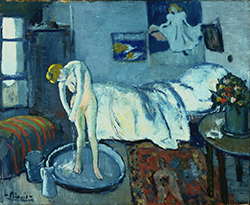In 1967 French theorist Roland Barthes famously pronounced the death of the author. Barthes argued against seeing a work of literature as a reflection of its creator, but rather a transcription of ideas and language that presents something larger than the mind of the writer. “We know now that the text is not a line of words releasing a single ‘theological’ meaning,” Barthes argued, “but a multi-dimensional space in which a variety of writing, none of them original, blend and clash.” He added, “the text is a tissue of quotations drawn from the innumerable centers of culture.” Barthes was directing his argument to a new kind of critical, literary work where literature’s origins were a complex network of ideas and encounters by the reader, absent any intentions of the writer. In this idea of literature, a literature “without a field of origin,” the creator’s intentions disappear, for as he concludes, “the birth of the reader must be at the cost of the death of the Author.”
- “Becoming Picasso,”
Through May 26, 2013.
The Courtauld Institute of Art, London. - “Ice Age Art: Arrival of the Modern Mind,” Through May 26, 2013. The British Museum, London.
These days Barthes ideas about the author seem a mixture of stale postmodern hyperbole with a dose of prophetic insight. His arguments on the nature of writing are quite prescient in an age where texts circulate, and recirculate in a “tissue of quotations” on the Internet. But more directly, Barthes critiques on the nature of artistic originality and creative genius reimagine the origins of any one work as always floating in a network of ideas and stories, images and concepts that are borrowed, copied, reconfigured and made anew. It is not the death of the author per se that matters, but rather the death of the idea that the author or artist work alone.
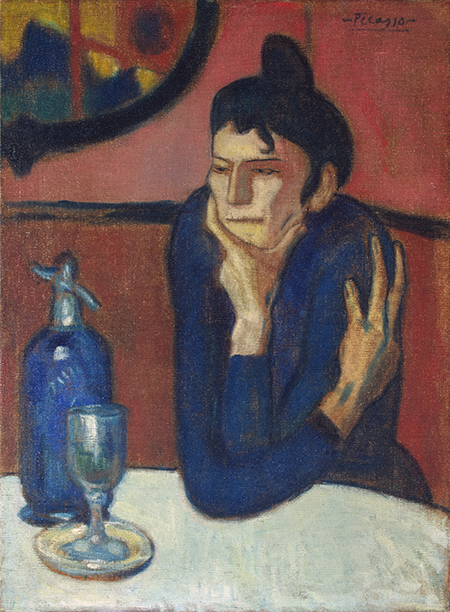
“Absinthe Drinker” (1901)
I thought about Barthes ideas as I wandered the show “Becoming Picasso,” a small exhibition focused on the work he completed in 1901 when he moved to Paris and set up a studio in Montmartre. Ambroise Vollard, the patron and promoter of Cezanne, Degas, and Toulouse-Lautrec, had granted the 19-year-old Spaniard a show in the summer of that year, a joint exhibition with the 37-year-old Basque painter Francisco Iturrino. The show would establish Picasso’s reputation. We don’t remember much of Iturrino’s work, though both were creating richly imagined post-Impressionist canvases that were valued by Vollard’s patrons. Picasso worked feverishly in the weeks before the exhibition, producing as many as three canvases a day, so the story goes. When the show opened on June 25th, there were sixty-four paintings from Picasso’s frenzied month of work (one can imagine that he produced much more than what Vollard selected). The reviews were strong, and Picasso’s position in the Paris art world would grow over the next decades.
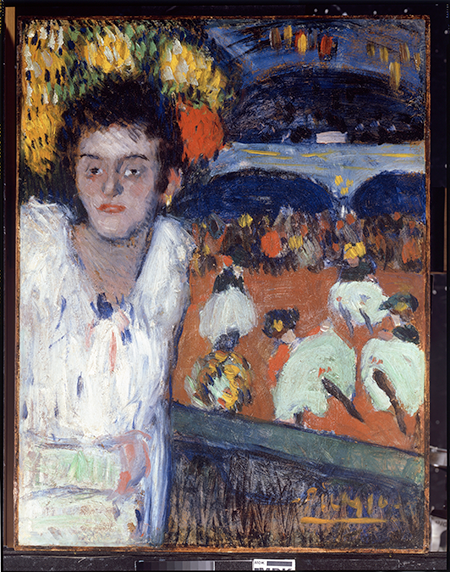
“At the Moulin Rouge” (1901)
A small selection of paintings from that gallery show make up the first half of this exhibition and reveal an artist mirroring the styles and subject matter of French post-Impressionism. You can tell these works were done with a fevered and rushed impulse. The brushstrokes swirl with energy; the compositions exude the light and color of Montmartre nightlife, scenes of performers and patrons that crowd these canvases. “At the Moulin Rouge” for example, the frenetic atmosphere in colors and brushstrokes render the demi-monde in bright surfaces and movement. Everywhere you turn in these canvases you see the echoes of Vollard’s most cherished French painters. The Can-Can dancers of Toulouse-Lautrec, the flat geometrical shapes of Cezanne, and the delicate brushwork of Degas all reflect an artist borrowing, stealing, and remixing.
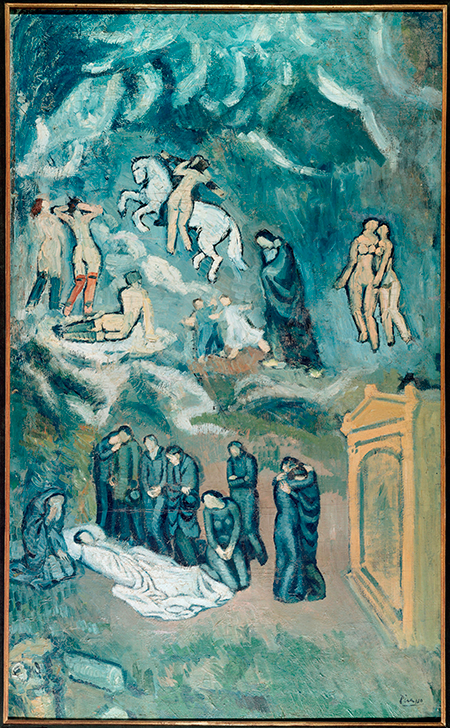
“Evocation (The Burial of Casagemas” (1901)
But it was the suicide of Picasso’s good friend and artist Carles Casagemas that provoked the darker paintings of what we call the artist’s Blue Period, and signal his move away from the echoes of post-Impressionist style. In February of 1901, while Picasso was still in Barcelona, Casagemas, distraught over his passionate attraction for his model Germaine Gargallo, shot himself in the temple while out with Gargallo and a group of friends at the famed Hippodrome nightclub on Boulevard de Clichy. His death haunted Picasso and prompted three paintings that imagined the funeral scene of Casagemas. These works were not shown in public until the 1960s. “Casagemas in his Coffin” is one of the quietest paintings in this show, its composition of dark blues and greens present an intimate profile portrait of the dead artist. Such melancholy colors and subject matter would anchor his canvases through the latter parts of the year. These works reflect less the light and energy of Monmartre nightlife and more the somber portraits of those on the margins. Gone is the energy of dancers and spectators, replaced by solitary figures, drinkers and harlequins, absorbed in their own silent, static moments. The Blue Period began Picasso’s move to more original canvases. As this show makes clear, the death of Casagemas gave birth to Picasso the artist.
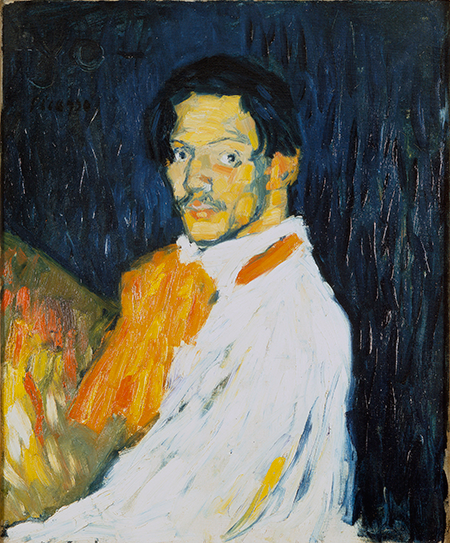
“Self-Portrait (Yo – Picasso)” (1901)
Another story of this year 1901 can be found in the striking self-portrait of Picasso. Entitled “Self-Portrait” (Yo-Picasso)” it presents the young artist in a richly textured white shirt, a flowing orange cravat, his face angular and handsome, illuminated as if on a stage looking every bit the dandy artist. It was, as the wall text tells us, the moment when the artist eschewed his full name in signing his paintings. Instead, he simply used “Picasso.” In this self-portrait, he also inscribed in the dark background the word “Yo” or “I” affirming not only his presence in word and image, but also his singularity.
This self-portrait contrasts sharply with another, smaller one hanging nearby, where the painter presents himself in a darker mood, the browns and grays muting the exuberance of the other portrait, presenting him as a more serious and brooding artist. He was inclined to such variations throughout his life. But in 1901 his self-portraits were crucial to his art. Some critics called him “la petite Goya.” Those critics who were dazzled by his works in the Vollard show praised him for canvases that echoed and celebrated the styles of post-Impressionism. “Yo-Picasso” was as much a self-portrait as it was an assertion of an individual, creative talent against those critics who define him in the reflections of others. Picasso knew well the rules of the art world in turn-of-the-century Paris. As C.F.B. Miller writes in his catalog essay, this early image of his creative presence was to be crucial to Picasso’s sense of himself as an artist. A large part of Picasso’s historical importance rests on how he fostered an idea of artistic genius. Quoting John Berger’s study of the artist, Miller notes that Picasso’s success throughout his life had less to do with his work, and more with the “result of the idea of genius which he provokes.” Our attraction to Picasso’s paintings and sculptures is an attraction to the idea of an artist who appears uniquely talented.
And this is what is most curious about “Becoming Picasso.” In focusing on Picasso’s life in 1901 it enacts a compelling creation story, filled with the usual elements of death and rebirth, of conflict and transformation. It confirms a story of Picasso as much as if feeds an idea about artistic genius as a singular identity, self-possessed and understood. Such creation stories are useful in turning art into the artist, transforming the intrigue of the canvas to the genius of the creator. Leaving this show, I wondered if there is any way of seeing a Picasso painting beyond Picasso?
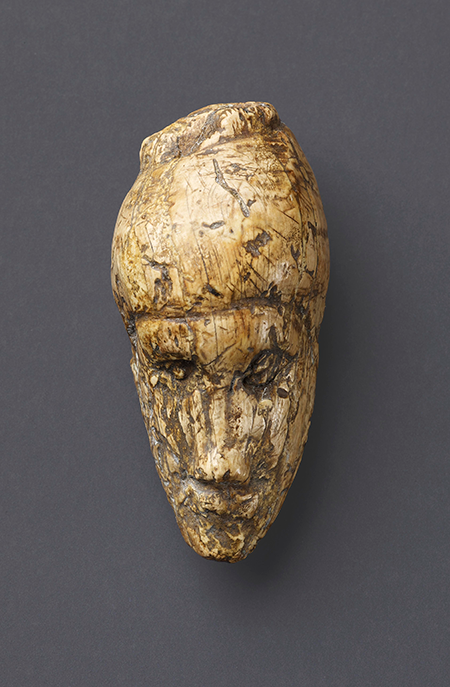
The oldest known portrait of a woman sculpted from mammoth ivory. Found at Dolni Vestonice, Moravia, Czech Republic. c.26,000 years old. Moravian Museum, Anthropos Institute
To think of this question another way, take a moment in another exhibition in London this spring, “Ice Age Art: Arrival of the Modern Mind” at the British Museum. One of the first objects you encounter is a small Mammoth ivory sculpture of a woman, created more than 20,000 years ago. Not much larger than a child’s hand, the sculpture is roughly hewn on the bottom, but the shape of the woman’s figure is round and smooth, almost delicate in its expression of the human form. Sitting in a glass box entitled “Ice Age Modernism” the sculpture is next to a photograph of a cabinet in Picasso’s studio where he kept a reproduction of this sculpture, along with other copies of pre-historic artifacts and African masks. We see these sculptures and artifacts throughout Picasso’s cubism, illuminating again and again how much the artist borrowed and repurposed objects and aesthetics as material in his compositions. But here, in “Ice Age Art,” modernist art from the early 20th century hover on the walls around the glass displays cases, tempting us to imagine European modernism as something more than a late 19th century invention. Can we really see this small sculpture of a female, hewn thousands of years ago by a culture we have little insight about, as anything more than a curiosity in Picasso’s cabinet, or an inspiration for modernism?
While “Becoming Picasso” focused on a small moment in time to tell a story of the artist’s modernist, aesthetic birth, this show spans millennium offering a loosely organized creation story about modernism itself, presenting one of the oddest ideas about art that I’ve encountered in years. Or, as one of the wall text offers: “The Ice Age artists had the same modern visual brain as our own.” And from this, the curators present a story about prehistoric artifacts and modernist aesthetics, drawing subtle connections between our contemporary notions of the “artist” and “art” and those drawings and sculptures from an age we can barely even fathom.
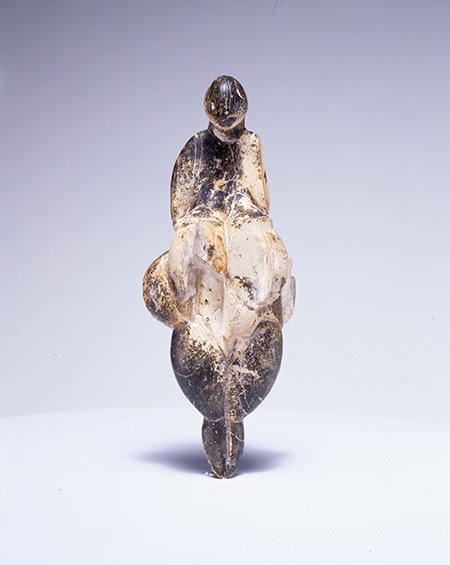
“Venus de Lespugue.” Collection d’anthropologie du Museum national d’Histoire naturelle / Musee de l’Homme. Copyright of MNHN – MH / Daniel Ponsard.
Take “Venus of Dolní Věstonice.” This sculpture stands in a small case in the second gallery space and is one of the oldest known ceramic sculptures, dating from between 29,000 and 25,000 years ago. The figure is that of a woman, round and rich, her body created out of smooth surfaces. Encountering the small, careful figure I wondered what we don’t see when we call it art, when we sit it beside the familiar abstraction of modernism. Nearby the Venus is a lithograph by Matisse from 1906 of a nude reclining woman, the weighty body rendered in short lines suggesting the pose more than the details. The connections we are asked to see is one of form. The modernists of the 20th century were tapping into an evolutionary thread of aesthetics that stretches into the far reaches of European history, so this show suggests.
But this again is a story of genius rather than culture. This show offers up modernism not as an aesthetic of found artifacts, reimagined and circulated in new forms, but rather as a kind of individual force of creative energy that has been evolving through thousands of years. It is an evolutionary story of art, that situates modernism — and our own era — as a heighten state of being. This is art history told backwards, from our present to the farthest reaches of human creation. “Throughout this art,” the introductory text tells us, “Ice Age communities tried to understand themselves and their place in the world.” It is of course a big claim to make about peoples and communities so mysterious to us. Haunting such claims is an idea about the relationship between image making and identity that comes to us from the 19th century rather than those Ice Age communities.
Some years ago art historian Hans Belting argued for what he called an “era of art,” which began in the Renaissance and ran through to the 1960s, to about the moment that art and artists began to question the history of art itself. That was about the same moment when Barthes declared the death of the author. It was in this era of art where image making transformed from pure iconography into distinct forms of art. The subject of art became increasingly secular as images lost their power as mystical and religious forces it had in the Dark and Middle Ages. New tools of art making and new technologies of art were invented such as oil paint and canvas, and later the photographic image. Along with these new tools, were explorations into what constitutes the proper subject of art in an increasingly secular world, guided in part by systems of galleries and patrons, salons and exhibitions. And it was within this era, most acutely in the Romanticism of the 19th century, that the artist emerged as a cultural figure, an invention of art itself. Picasso’s self-portrait and his show at the Vollard Gallery in Paris in 1901 are inventions of this era of art.
At one point in “Ice Age Art” I watched as a mother knelt down near her young daughter and pointed to an ivory sculpture of a lion, poised upright looking half human, half animal. “Look at this,” the mother said trying to attract the child’s attention, “this sculpture is over 25,000 years old.” What, I thought, would such a number mean to that little girl. And then I wondered what does it mean to us? Such distance and abstraction can easily foster creation stories that turn our own ideas of art into naturally occurring concerns across vast spaces of time.
We know so little about Ice Age man, and certainly about why they would carve figures into ivory tusks or take care to scratch well crafted and often realist drawings of birds or tigers on clay tablets. We wonder about those famous cave drawings in the south of France and Spain, rendered with earthen hues depicting scenes of animals now long gone from the European landscape. Such drawings were done in the deep recesses of the caves, and while there are theories of their meaning and purpose, we can only guess. In a small room in this show, a film projected a collage of these cave drawings that shimmered and shifted across a black wall molded to resemble the rough contours of the interior of a cave. It was meant to help us understand what it was like to create such works in the darkness of those spaces, of putting us in the place of Ice Age man. But of course film projections of cave drawings illuminated on a plastic wall in the British Museum only remind us how very distant we are from those cave painters.
Calling these artifacts and images art and their creators artists loses a sense of art’s cultural and historical meanings. It turns these Ice Age objects into a troubling contemporary notion of image making that leave us little space to question our own inventions of the artist, and our own ideas about creativity over the years. Both of these shows remind us how strong the idea of artistic originality can be to the stories we tell about art, illuminating as much it distracts us. They also remind us that such ideas are as fragile as a 20,000 year-old ivory sculpture, prompting me to wonder what generations in a millennium from now will make of Picasso’s dashing self-portrait. • 9 April 2013
